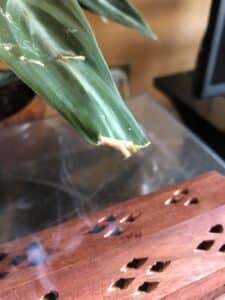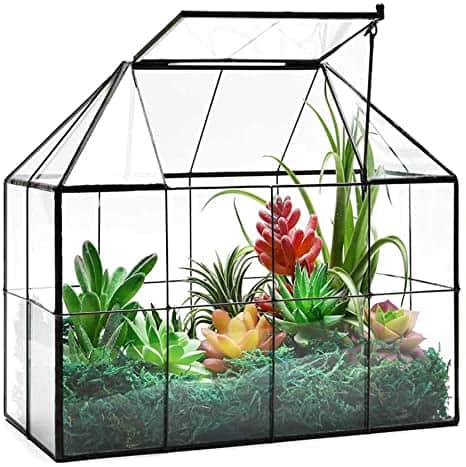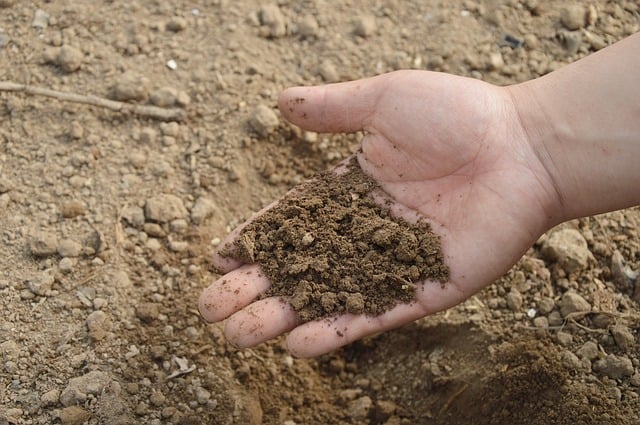Stromanthe is a low-maintenance plant with striking colorful foliage. I love them, especially because of their varieties in foliage.
This exotic plant is a must-have if you want your living space aesthetically decorated!
Brown tips and edges on your Stromanthe can worry you. However, there are ways to protect and care for your Stromanthe plant.
Generally, Stromanthe leaves can turn brown on the edges due to the salty water, overfertilization, sunburn, air current, temperature issues, low humidity, pests, and diseases.

However, you can treat your Stromanthe and heal it, given you diagnose your plant correctly.
There are numerous methods to protect and treat your plant in case of brown edges. Continue reading the article to find out.
Table of Contents
Is it Normal for Stromanthe Leaves to Turn Brown?
You may assume something is wrong with Stromanthe if its leaves go brown from the tip and edges.
However, it may not always be true.
If the cause is natural aging, it’s normal for Stromanthe leaves to turn brown.
However, besides aging, there can be other serious underlying causes to go green, healthy leaves brown.
If there is no new growth and Stromanthe leaves are turning brown, you need to check on water, fertilizer, pests, sunlight, temperature, humidity, and many more.
Are your other houseplant’s leaves turning yellow? Read on about Pothos leaves turning brown.
Reasons that Cause Stromanthe Leaves to Turn Brown
Brown edges on the leaves of Stromanthe show your plant is not doing so well.
Furthermore, brown edges look aesthetically unpleasing as well.
You need to find the underlying reason and work on it.
Check on the following common reason that can turn Stromanthe leaves brown.
| Causes | Solutions |
|---|---|
| Water Quality (includes chlorine and salts) | Use filtration or sedimentation method and water your plant |
| Direct Sunlight | Provide indirect sunlight using sheer curtains or other similar blockage |
| Low Humidity | Keep the plant in the area with good humidity like bathrooms and kitchen |
| Dry Soil | Use a bit slow draining soil and water adequately |
| Waterlogged soil | Use well draining soil and water a little less |
| Air Currents | Keep the plant away from ACs, fans and heaters |
| Temperature | Maintain 70 degrees temperature |
| Overfertilization | Fertilize once in 2-3 weeks only in growing season |
| Pests, Fungal, and Bacterial infection | Clean the leaves on both sides and use antifungal-bactericidal sprays |
1. Water Quality
Water is the essential component playing a key role in keeping your Stromanthe healthy.
We use tap water to water our houseplants.
The tap water contains different elements that can build up in the soil in the long run.
Elements like chlorine, fluorine, some salts, and minerals can stress the plant leading to leaf burn turning brown on the edges.
Water the plant once a week, but before watering, check if the top few inches of soil are dry or not. You need to wait till it dries in case if it’s wet.
Solutions
- You can use a water filtration technique to free it from salts, minerals, and other unnecessary elements that burn the plant.
- Fill water in a container and keep it overnight before using it to water your Stromanthe plant.
- Tap water contains chlorine and other salts. Over time the salt build-up can affect the plant. Hence use rainwater if possible.
- Underwatering and overwatering can also cause brown tips. Water the plant once the top few inches of soil is dry.
- Coldwater can cold shock the plant. Hence, you should use room temperature water to water your plants.

2. Direct Sunlight
Stromanthe loves bright indirect sunlight. However, direct sunlight is bad.
You can keep your Stromanthe in a spot where it receives enough sunlight, given its indirect.
Direct sunlight is not good for Stromanthe because it burns the leaves. Excessive scorching of leaves leads to brown leaves in no time.
Additionally, direct sunlight encourages excessive respiration and wilting of the plant.
Solutions
- Brown leaves cant be recovered. The initial sign of leaf burn shows wilting and discoloring to reddish or yellow. Place the plant in shades to let it heal.
- You can also rotate the plant, so all parts of it receive sunlight equally.
- If your indoor Stromanthe is showing the signs of sunlight burn, move the plant to the northern window or keep it in shades for some hours of the day.
Are you worried about how to take care of houseplants in cold? Read on: How to Care for your Indoor Rubber Plant During Winter?
3. Low Humidity
Stromanthe is a tropical plant. Therefore, it requires good humidity to maintain the healthy leaves.
The humidity of 30% to 50% is best for Stromanthe.
Humidity below 30% leads to wilting, crispy, and brown leaf tips.

You can increase the humidity simply by misting the leaves of Stromanthe even so often.
You can also install a humidifier during the colds.
We use an air conditioner twelve months a year, either for warmth or for cold. However, it is harmful to Stromanthe.
Hence keep your Stromanthe away from the air conditioner because it drops the humidity.
If the Stromanthe leaves are crispy as they go brown on the tips, it’s definitely due to low humidity.
Solutions
- Place your Stromanthe away from AC or heater.
- Mist the plant often so as to retain moisture. However, do not water directly on the leaves as it can cause spotting on the leaves.
- Install an artificial humidifier if needed.
- You can keep the Stromanthe in a spot with higher humidity during the colds. For example, bathrooms and the kitchen have relatively higher humidity.
- You can also use a Humidity tray to hold water for your plants. It increases the air humidity around your plant. Pebble humidity trays are common among houseplant owners.
- You can use a Humid terrarium for your plants to maintain good humidity. The humid terrarium provides a closed atmosphere and traps the humidity hence your plants can stay in well-trapped humidity.

4. Dry Soil
If you underwater the plant, it’s most likely to get dry. Other than that, fast-draining soil is to blame in most cases.
Therefore, make sure you water your Stromanthe when the top few inches of soil seem dry to you.
If the soil gets dry, Stromanthe leaves can go dry, limp, and droop. Eventually, they will start curling and going brown from the tip.
When your plant is sensitive to overwatering as well as underwatering, maintaining a good watering schedule can get tricky!
Light watering may not be sufficient for plants to absorb enough water.
This is because a small amount of water cannot reach the roots, so the Stromanthe cannot absorb the required moisture.

Solutions
- Use approximately 1.5 liters of water to water your Stromanthe plant so that every root receives water. Let the water run through the drainage hole.
- Water the plant weekly or if the top 1-2 inches of soil looks dry.
- Use a little less draining soil if your used potting mix is too fast draining for your Stromanthe.
- Too much salt build-up can also cause brown leaf tips, so changing the potting mix once in 1-3 years is advisable.
- You can use potting soil, peat moss, and perlite as an ideal mixture for Stromanthe.
- If your plant is underwater for a long time, you can soak bath the plant. Fill your basin with water and dip your plant in it for 45 minutes.
5. Water Logged Soil
Waterlogged soil is one of the common problems faced by house plant owners.
The soil is wet and soggy almost all the time due to overwatering because the water is unable to drain away as required by your Stromanthe plants.
While making the potting mixture, you need to be extra careful to make the soil well draining for your Stromanthe plants.
Stromanthe leaves will go dark along their mid-leaf margin and slowly starts going brown.
Prolonged waterlogged soil and compact soil can lead to root rot. In addition, Stromanthe roots do not like to stay in soggy soil for a longer period.
When the roots start rotting, the plant can’t absorb enough water. hence the leaves start yellowing and eventually start turning brown.
Root rot can lead to more damage to your Stromanthe. Stromanthe requires well aeration as well.
Solutions
- First, check if the drainage holes are blocked. If any of them is blocked, remove the blockage immediately.
- Keep the plant in a spot where it receives bright indirect sunlight so that the soil can dry away.
- Check if the soil is properly aerated. Compact soil also can lead to water-logged soil. Create holes with a stick or pencil in the soil to help with aeration.
- If the problem is root rot, you need to re-pot your Stromanthe plant with a well-draining potting mix.
For the preparation of well-draining potting mix, use:
- 2 part potting soil
- 1 part perlite
- 1 part peat moss and
- 1 part sand
You can re-pot waterlogged plants. Read on: How to Propagate Ponytail Palm Plants?
6. Air Currents
Along with the evolving technologies, it’s not a new thing that we use air conditioners or artificial heating sources to make our living space best for us.
However, they can drought stress your houseplants.
Along with them, air drafts through an open window can also sometimes affect the plant near it.
Stromanthe leaves can get dry due to air current resulting in brown leaf edges and tips.
Here are some of the tips to try if the problem is air current.
Solutions
- Place the plant near the window where it receives enough indirect sunlight but not too much air current.
- Keep the plant away from fans, air conditioners, or heaters.
- Mist the leaves once in a while.
7. High Temperature
Although Stromanthe is a good temperature-loving plant, excess heat can burn the leaves and turn them brown.
Stromanthe prefers a warm temperature of between 56 to 80 degrees Fahrenheit during the day and around 60 degrees Fahrenheit during the night.
You should not keep the plant in a place where it receives excess heat. Placing it outdoor with the too-bright sun also can burn their leaves.
Temperature higher than 80 degrees Fahrenheit burns the Stromanthe leaves.
Solutions
- Keep your Stromanthe away from the spot where it receives excess heat through the window.
- Try to maintain the room temperature to 70 degrees Fahrenheit during the day and around 60 degrees during the night.
- If your Stromanthe is outdoor, move it to a more shady place or bring it indoors.
8. Overfertilization
If you have the habit of fertilizing your house plants in a correct manner and as per the plant’s need, it will always do good for your plant.
However, overfertilization is harmful to the plants.
Overfertilization can also lead to salts build up in the soil. Hence, the salt build-up will increase, eventually leading to plant burn.

Overfertilization causes yellow and brown leaves along with wilting.
In the long run, it may kill your Stromanthe.
Hence, if you are fertilizing too much to grow your Stromanthe faster, you are not doing right by your plant!
Solutions
- Fertilize your Stromanthe in 2-3 weeks during its growing season. You can cut off the fertilization during the winter.
- Water, the plant well until the water, runs through the drainage holes. So you can wash off the excess salts and fertilizers from the soil and roots by running water through the pot and roots.
- Do not forget to dilute the soluble fertilizer to one-quarter strength before feeding your plant. You can use Miracle-Gro Indoor liquid feed, Purived Liquid Fertilizer, or any other suitable houseplant fertilizer.
If you want to learn more about other different types of prayer-plants then check our another article on 15 Different Types of Prayer Plants
Should I Remove the Brown leaves?
Once the edges or tips of Stromanthe go brown, there is no way they will go green, no matter what you do.
You should remove the brown leaves because they can take energy from the plant.
You can just trim them off with a sterile tool and give your plant a fresh look!
You need to identify the cause of brown leaves and work on it. Then, you can work on solutions and take the necessary precautions.
If the brown tips are due to root rot or overfertilization, it’s best to re-pot your Stromanthe.
You can follow the following steps to trim off your plant’s brown leaves:
- Take sterilized pruning shears or a pair of scissors based on what works best for you.
- Identify the infected leaves, yellow and brown leaves. Remove the fallen leaves from the plant and pot.
- Cut at the base of the leaf if it’s entirely brown.
- For the leaves with brown edges and tips, trim off only the infected parts.
Tips to Take Care of Stromanthe
Taking care of houseplants is easier said than done. However, Stromanthe is a low-maintenance plant and does not require much care.
However, there are some tips that can come in handy if anything goes south while owing them.
- Check your plant with a touch test, weight lifting method, or moisture meter before watering the plant if your plant has undergone recent underwatering or overwatering stress.
- Use the suitable potting mix. Too fast-draining soil cant hold moisture for long and too slow draining soil creates soggy soil leading to root rot.
- Make sure the soil is moist but never soaked.
- If you notice a new leaf of Stromanthe coming out damaged and brown, then make sure to check for the pests because they do hide inside the new leaf and will show up as the leaves unfurl.
- Keep your Stromanthe in a spot where it can receive enough indirect sunlight.
- Provide good humidity to the plant. You can add pebbles to your pot or use a humidity tray.
- You can add mulch as an insulator for both heat and cold.
- Protect the plant from pests and diseases. Dust your plant periodically to prevent the infestation of pests.
Taking care of every houseplant is a must-know. Read on: How to Take Care of Your Lavender Topiary?
Conclusion
Stromanthe is a low-maintenance plant that thrives on proper watering and bright indirect sunlight.
However, too much sun and excess heat can burn the plant leaves, turning them brown.
Taking care of houseplants is easy once you know them.
Overfertilization, too much water, or too little water can lead to brown tips.
Water the plant correctly and provide all the basic requirements of your Stromanthe to keep it healthy and happy.
Make sure you diagnose your Stromanthe plant correctly before starting the treatment!
Observe the plant and let it talk to you!


